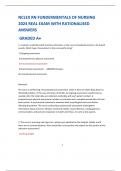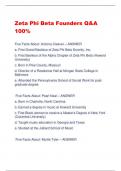NCLEX RN FUNDERMENTALS OF NURSING 2024 REAL EXAM WITH RATIONALISED ANSWERS GRADED A +
1. A patient is admitted with shortness of breath, so the nurse immediately listens to his breath sounds. Which type of assessment is the nurse performing?
1) Ongoing assessment
2) Comprehensive physical assessment
3) Focused physical assessment
4) Psychosocial assessment - ANSWERS-Answer:
3) Focused physical assessment
Rationale:
The nurse is performing a focused physical assessment, which is done to obtain data about an identified problem, in this case shortness of breath. An ongoing assessment is performed as needed, after the initial data are collected, preferably with each patient contact. A comprehensive physical assessment includes an interview and a complete examination of each body system. A psychosocial assessment examines both psychological and social factors affecting the patient. The nurse conducting a psychosocial assessment would gather information about stressors, lifestyle, emotional health, social influences, coping patterns, communication, and personal responses to health and illness, to name a few aspects.
2. The nurse is assessing vital signs for a patient just admitted to the hospital. Ideally, and if there are no contraindications, how should the nurse position the patient for this portion of the admission assessment?
1) Sitting upright
1 2) Lying flat on the back with knees flexed
3) Lying flat on the back with arms and legs fully extended
4) Side-lying with the knees flexed - ANSWERS-Answer:
1) Sitting upright
Rationale:
If the patient is able, the nurse should have the patient sit upright to obtain vital signs in order to allow the nurse to easily access the anterior and posterior chest for auscultation of heart and breath sounds. It allows for full lung expansion and is the preferred position for measuring blood pressure. Additionally, patients might be more comfortable and feel less vulnerable when sitting upright (rather than lying down on the back) and can have direct eye contact with the examiner. However, other positions can be suitable when the patient's physical condition restricts the comfort or ability of the patient to sit upright.
4. The nurse is providing diabetic diet teaching to a Hispanic man and his wife. When the nurse is discussing foods that are acceptable, the wife continues to interrupt with statements like, "Oh, he doesn't eat that," or, "All he eats is rice and beans." What should the nurse do?
a. Ask the wife to leave so he/she can focus on teaching the patient.
b. Explain how "rice and beans" are not acceptable foods on a diabetic diet.
c. Provide a diet plan with only food alternatives selected by the patient.
d. Refer the patient and his wife to a dietitian familiar with Spanish food choices. - ANSWERS-
ANS: D
The nurse should refer the patient to speak with a dietitian who is familiar with cultural food choices. If possible, he/she should develop a diet plan that includes the patient's cultural diet preferences and can provide culturally sensitive teaching brochures that describe healthy food choices. Rice and beans may be acceptable alternatives in a balanced diet. The nurse should include people in the family who help shop for and prepare food in the home, along with the wife.
5. How should the nurse modify the examination for a 7-year-old child?
2 1) Ask the parents to leave the room before the examination.
2) Demonstrate equipment before using it.
3) Allow the child to help with the examination.
4) Perform invasive procedures (e.g., otoscopic) last. - ANSWERS-Answer:
2) Demonstrate equipment before using it.
Rationale:
The nurse should modify his examination by demonstrating equipment before using it to examine a school-age child. The nurse should make sure parents are not present during the physical examination of an adolescent, but they usually help younger children feel more secure. The nurse should allow a preschooler to help with the examination when possible, but not usually a school-age child. Toddlers are often fearful of invasive procedures, so those should be performed last in this age group. It is best to perform invasive procedures last for all age groups; therefore, this does not represent a modification.
6. Foster (1976) identified two distinct categories of healers cross-culturally. Of the following characteristics, which are congruent with the healing practices of naturalistic practitioners? (Select all that apply.)
a. Illness is impersonal and is due to biological forces.
b. Illness is caused by alterations in the body equilibrium .
c. Sorcerers can cause health and illness.
d. Human relationships should be emphasized.
e. Healing modalities include herbs, massage, and surgery . - ANSWERS-ANS: A, B, E
Naturalistic practitioners attribute illness to natural, impersonal, and biological forces that cause alteration in the equilibrium of the human body. Healing emphasizes use of naturalistic modalities, including herbs, chemicals, heat, cold, massage, and surgery. In contrast, personalistic practitioners believe that an external agent, which can be human (i.e., sorcerer) or nonhuman (e.g., ghosts, evil, deity), causes health and illness. Personalistic beliefs emphasize the importance of humans' relationships with others, both living and deceased, and with their deities
3 7. The nurse must examine a patient who is weak and unable to sit unaided or to get out of bed. How should she position the patient to begin and perform most of the physical examination?
1) Dorsal recumbent
2) Semi-Fowler's
3) Lithotomy
4) Sims' - ANSWERS-Answer:
2) Semi-Fowler's
Rationale:
If a patient is unable to sit up, the nurse should place him lying flat on his back, with the head of the bed elevated. Dorsal recumbent position is used for abdominal assessment if the patient has abdominal or pelvic pain. The patient in dorsal recumbent is on his back with knees flexed and soles of feet flat on the bed. Lithotomy position is used for female pelvic examination. It is similar to dorsal recumbent position, except that the patient's legs are well separated and thighs are acutely flexed. Feet are usually placed in stirrups. Fold sheet or bath blanket crosswise over thighs and legs so that genital area is easily exposed. Keep patient covered as much as possible. The patient in Sim's position is on left side with right knee flexed against abdomen and left knee slightly flexed. Left arm is behind body; right arm is placed comfortably. Sims' position is used to examine the rectal area. In semi-Fowler's position, the patient is supine with the head of the bed elevated and legs slightly elevated.
8. The nurse should use the diaphragm of the stethoscope to auscultate which of the following?
1) Heart murmurs
2) Jugular venous hums
3) Bowel sounds
4) Carotid bruits - ANSWERS-Answer:
3) Bowel sounds
4





